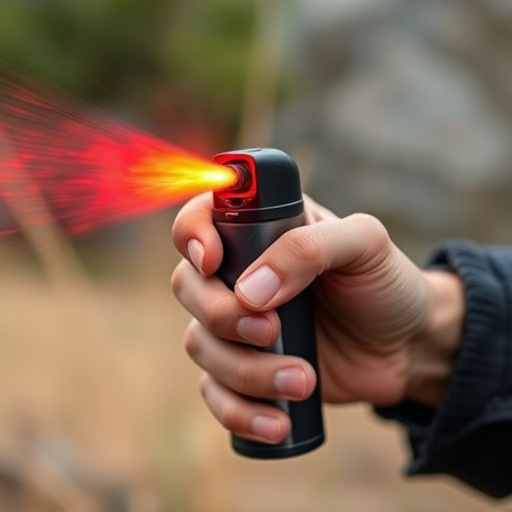Understanding Chemical Irritants: The Science Behind Pepper Spray highlights that pepper spray, a powerful personal protection tool, utilizes capsaicin from chili peppers to irritate an assailant's eyes, nose, and respiratory system. Safe and responsible use involves assessing threats, justifying force, understanding its limitations, undergoing proper training, and adhering to local regulations. Key points for "When to Use Pepper Spray Safely" include objectivity in threat assessment, targeted deployment, training, minimizing bystander harm, and legal considerations. Effective deployment depends on proximity, attacker sensitivity, weather conditions, aiming at the face or eyes, and post-use distance. Staying calm, aware, and familiar with self-defense laws is equally vital alongside physical actions.
“In today’s unpredictable world, personal protection is paramount. One of the most effective tools in an individual’s arsenal is pepper spray, a chemical irritant designed to disable and deter aggressors temporarily. This article delves into the science behind pepper spray, exploring its mechanism of action and the specific conditions under which its use is legal and safe. We’ll guide you through best practices for deployment, ensuring you’re prepared with the knowledge to use this powerful personal protection device responsibly.”
- Understanding Chemical Irritants: The Science Behind Pepper Spray
- When is Pepper Spray Legal and Safe to Use?
- Best Practices for Using Pepper Spray for Personal Protection
Understanding Chemical Irritants: The Science Behind Pepper Spray
Understanding Chemical Irritants: The Science Behind Pepper Spray
Chemical irritants, particularly pepper spray, are designed to disrupt an assailant’s vision and breathing by triggering a painful irritation in the eyes, nose, and respiratory system. These devices contain capsaicin, the active ingredient found in chili peppers, which is highly effective in incapacitating an attacker temporarily. When used safely and responsibly, pepper spray can serve as a powerful personal protection tool.
When to Use Pepper Spray Safely involves assessing potential threats and understanding its limitations. It’s crucial to ensure that the use of force is justified and proportionate to the perceived danger. Proper training in the handling and deployment of pepper spray is essential to minimise risk of injury to oneself or bystanders, as well as to maximize its effectiveness against an attacker.
When is Pepper Spray Legal and Safe to Use?
Pepper spray, a popular chemical irritant used for personal protection, is only legal and safe to use in specific circumstances. Its application is governed by local laws and regulations, which vary significantly from one region to another. Generally, pepper spray is considered a legal defense when an individual feels threatened or is facing an imminent physical attack. It’s crucial to understand that using pepper spray recklessly or excessively can lead to severe consequences, including potential harm to bystanders and legal repercussions.
When considering when to use pepper spray safely, it’s essential to assess the situation objectively. If you perceive a credible threat to your safety or that of others, and all other reasonable means of de-escalation have been exhausted, pepper spray may be justified. Always aim for non-lethal areas like the face and eyes, ensuring minimal impact on bystanders. Regular training in its proper use is recommended, as it helps users understand safe application techniques, reduce the risk of accidental discharge, and enhance overall effectiveness in emergency situations.
Best Practices for Using Pepper Spray for Personal Protection
When to Use Pepper Spray Safely
Knowing when and how to deploy pepper spray is crucial for personal safety. Pepper spray should be considered a last resort when facing an imminent threat or attack from an aggressor, as its effects can cause temporary disorientation and difficulty breathing. It’s important to note that pepper spray doesn’t always guarantee your safety; its effectiveness varies based on factors like the proximity of the attacker, their sensitivity to capsaicin (the active ingredient), and weather conditions.
Best practices involve training in proper usage techniques, ensuring your spray is easily accessible, and keeping it fresh through regular maintenance. Always aim for the face or eyes, as these areas are most sensitive to the irritant. After deployment, move to a safe distance to avoid inhaling residual spray. Remember that self-defense isn’t just about physical actions; staying calm, aware, and familiar with local laws pertaining to self-defense tools like pepper spray is equally vital.
Pepper spray, as a chemical irritant for personal protection, offers a safe and effective solution when used appropriately. Understanding the science behind its irritation capabilities and adhering to best practices ensures its legality and maximum effectiveness. Knowing when and how to deploy pepper spray can empower individuals to protect themselves in various situations, providing a crucial layer of security in today’s diverse and sometimes unpredictable world. Always remember, responsible use is key to leveraging the benefits of this powerful personal protection tool while navigating legal boundaries.
